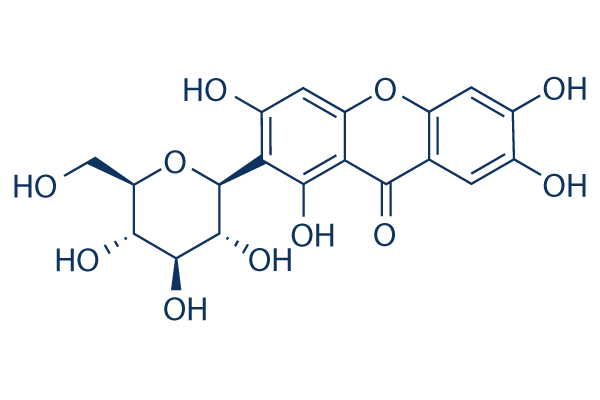|
受注:045-509-1970 |
技術サポート:tech@selleck.co.jp 平日9:00〜18:00 1営業日以内にご連絡を差し上げます |
化学情報

|
Synonyms | Alpizarin, Chinomin, Hedysarid | Storage (From the date of receipt) |
3 years -20°C powder 1 years -80°C in solvent |
|||
| 化学式 | C19H18O11 |
||||||
| 分子量 | 422.34 | CAS No. | 4773-96-0 | ||||
| Solubility (25°C)* | 体外 | DMSO | 84 mg/mL (198.89 mM) | ||||
| 体内 (毎回新しく調製した物を用意してください) |
|
||||||
|
* <1 mg/ml means slightly soluble or insoluble. * Please note that Selleck tests the solubility of all compounds in-house, and the actual solubility may differ slightly from published values. This is normal and is due to slight batch-to-batch variations. |
|||||||
溶剤液(一定の濃度)を調合する
生物活性
| 製品説明 | Mangiferin (Alpizarin, Chinomin, Hedysarid) is a bioactive compound that demonstrates many health perspectives and has been used to prepare medicinal and food supplements. Mangiferin is a Nrf2 activator. Mangiferin suppresses nuclear translocation of the NF-κB subunits p65 and p50. |
|---|---|
| in vitro | Mangiferin possesses several health endorsing properties such as antioxidant, antimicrobial, antidiabetic, antiallergic, anticancer, hypocholesterolemic, and immunomodulatory effects. It suppresses the activation of peroxisome proliferator activated receptor isoforms by changing the transcription process. This compound protects against different human cancers, including lung, colon, breast, and neuronal cancers, through the suppression of tumor necrosis factor α expression, inducible nitric oxide synthase potential, and proliferation and induction of apoptosis. It also protects against neural and breast cancers by suppressing the expression of matrix metalloproteinase (MMP)-9 and MMP-7 and inhibiting enzymatic activity, metastatic potential, and activation of the β-catenin pathway. It has the capacity to block lipid peroxidation, providing a shielding effect against physiological threats. Additionally, this chemical enhances the capacity of the monocyte-macrophage system and possesses antibacterial activity against gram-positive and gram-negative bacteria. It exerts a pro-hypoglycemic role by modulating glucose metabolism, ameliorating insulin resistance, lowering cholesterol synthesis, and inhibiting the expression of the tumor necrosis factor α and inducible nitric oxide synthase. It also induces apoptosis and inhibits the progression and promotion of cell proliferation by interfering with cell cycle regulation, the signaling of several cancer transduction pathways in tumor cells[1]. |
| in vivo | Mangiferin can pass through the blood-ocular barrier and has been shown to be effective in curtailing various eye diseases. Administration of this compound (100 mg/kg BW) dissolved in corn oil in healthy male Swiss albino mice lowers the activity of lysosomal enzymes such as β-glucuronidase, acidphosphatase, β-galactosidase and N-acetyl glucosaminidase. Oral administration of this compound (100 miligram/kilogram BW) through the diet for 18 weeks significantly ameliorates the elevated levels of glycoprotein components, membrane lipid peroxidation, and ATPases in lung carcinoma-induced animals. It also ameliorates intestinal inflammation and impairs the gastrointestinal transit postoperative ileus (POI) of rats. This compound recovers delayed intestinal transit induced by intestinal manipulation. In mice, it shows a gastroprotective effect. Administration of this chemical (3, 10 and 30 mg/kg) decreases ethanol-induced gastric damage by 30, 35 and 63% respectively, and reduced indomethacin-induced gastric damage by 22, 23, and 57% respectively. In pylorus-ligated rats, gastric secretion and total acidity significantly decrease by this compound, and it effectively prevents the depletion of the ethanol-related protein from the gastric mucosa of the non-protein sulfhydryl content. This chemical exhibits an antidiabetic role in adult C57BL/6 J mice. It has a significant role in the reduction of cholesterol, triglycerides, and free fatty acid (FFA) levels in both serum and heart, and can also enhance heart tissue phospholipid levels in isoproterenol-induced cardiotoxic rats. This compound has a cytotoprotective role against the neurotoxicity and cognitive impairment induced by aluminium chloride in male Swiss albino mice[1]. |
プロトコル(参考用のみ)
| 細胞アッセイ | 細胞株 | RAW 264.7 cells |
|---|---|---|
| 濃度 | 10, 20 and 40 μM | |
| 反応時間 | 16 h | |
| 実験の流れ | RAW 264.7 cells are seeded in 6 well plates at a density of 2 × 105 cells/well and then pre-incubated with different concentrations of PT-Mangiferin (10, 20 and 40 μM). The cells are stimulated with LPS (1 μg/ml) for 16 h and then treated with 10 μM DCFH-DA (2',7'-dichlorodihydrofluorescein diacetate) and further incubated for 15 min at 37 °C. The cells are collected, washed with PBS and total of 10000 events are analyzed in FL1 channel by Flow cytometry. |
|
| 動物実験 | 動物モデル | Adult Balb/c male mice |
| 投薬量 | 5, 10 and 20 mg/kg | |
| 投与方法 |
参考
|
Selleckの高級品が、幾つかの出版された研究調査結果(以下を含む)で使われた:
| Mangiferin promotes osteogenic differentiation and alleviates osteoporosis in the ovariectomized mouse via the AXL/ERK5 pathway [ Front Pharmacol, 2022, 13:1028932] | PubMed: 36408274 |
長期の保管のために-20°Cの下で製品を保ってください。
人間や獣医の診断であるか治療的な使用のためにでない。
各々の製品のための特定の保管と取扱い情報は、製品データシートの上で示されます。大部分のSelleck製品は、推薦された状況の下で安定です。製品は、推薦された保管温度と異なる温度で、時々出荷されます。長期の保管のために必要とされてそれと異なる温度で、多くの製品は、短期もので安定です。品質を維持するが、夜通しの積荷のために最も経済的な貯蔵状況を用いてあなたの送料を保存する状況の下に、製品が出荷されることを、我々は確実とします。製品の受領と同時に、製品データシートの上で貯蔵推薦に従ってください。
